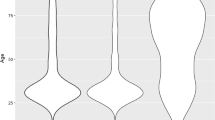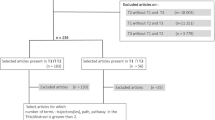Abstract
Context
The 30-day readmission rate after bariatric surgery is considered an important metric of the quality of hospital care. However, readmission rate beyond 30 days is rarely reported and does not provide any information about trajectories of care which would be of great interest for healthcare planning. The aim of this study was to analyze trajectories of care during the first year after bariatric surgery on a nationwide basis using data mining methods.
Method
This was a retrospective descriptive study on the trajectories of care within the first year after bariatric surgery. Data were extracted from a national administrative claims database (the PMSI database) and trajectories were defined as principal diagnosis of successive readmissions. Formal Concept Analysis was performed to find common concepts of trajectories of care.
Results
We included for analysis 198,389 bariatric procedures performed on 196,323 patients. Twelve main concepts were selected. About one third of patients (32.4%) were readmitted in the first year after surgery. Most common trajectories were as follows: regular follow-up (14.9%), cholelithiasis (2.2%), abdominal pain (1.9%), and abdominal sepsis (1.3%). Important differences were found in trajectories among different bariatric procedures: 1.8% of gastric banding patients had pregnancy-related events (delivery or medical abortion), while we observed a readmission rate for abdominal sepsis in 2.7% and 5.1% of patients operated of gastric bypass and sleeve gastrectomy respectively.
Conclusion
Administrative claim data can be analyzed through Formal Concept Analysis in order to classify trajectories of care. This approach permits to quantify expected postoperative complications and to identify unexpected events.


Similar content being viewed by others
References
Obésité et surpoids [Internet]. [cited 2019 Jul 22]. Available from: https://www.who.int/fr/news-room/fact-sheets/detail/obesity-and-overweight
Hall KD, Kahan S. Maintenance of lost weight and long-term management of obesity. Med Clin North Am. 2018;102(1):183–97.
Angrisani L, Santonicola A, Iovino P, et al. Bariatric surgery and endoluminal procedures: IFSO worldwide survey 2014. Obes Surg. 2017;27(9):2279–89.
Longitudinal Assessment of Bariatric Surgery (LABS) Consortium, Flum DR, Belle SH, et al. Perioperative safety in the longitudinal assessment of bariatric surgery. N Engl J Med. 2009;361(5):445–54.
Encinosa WE, Bernard DM, Du D, et al. Recent improvements in bariatric surgery outcomes. Med Care. 2009;47(5):531–5.
Regan JP, Inabnet WB, Gagner M, et al. Early experience with two-stage laparoscopic Roux-en-Y gastric bypass as an alternative in the super-super obese patient. Obes Surg. 2003;13(6):861–4.
Birkmeyer JD, Finks JF, O’Reilly A, et al. Surgical skill and complication rates after bariatric surgery. N Engl J Med. 2013;369(15):1434–42.
Buchwald H, Estok R, Fahrbach K, et al. Weight and type 2 diabetes after bariatric surgery: systematic review and meta-analysis. Am J Med. 2009;122(3):248–256.e5.
García-Ruiz-de-Gordejuela A, Madrazo-González Z, Casajoana-Badia A, et al. Evaluation of bariatric surgery patients at the emergency department of a tertiary referral hospital. Rev Espanola Enfermedades Dig Organo Of Soc Espanola Patol Dig. 2015;107(1):23–8.
Doumouras AG, Saleh F, Hong D. 30-day readmission after bariatric surgery in a publicly funded regionalized center of excellence system. Surg Endosc. 2016;30(5):2066–72.
Rosenthal RJ, Montorfano L, Abdemur A, et al. Readmission rates of bariatric procedures. J Am Coll Surg. 2015;221:e47–8.
Saunders J, Ballantyne GH, Belsley S, et al. One-year readmission rates at a high volume bariatric surgery center: laparoscopic adjustable gastric banding, laparoscopic gastric bypass, and vertical banded gastroplasty-Roux-en-Y gastric bypass. Obes Surg. 2008;18(10):1233–40.
Jay N, Nuemi G, Gadreau M, et al. A data mining approach for grouping and analyzing trajectories of care using claim data: the example of breast cancer. BMC Med Inform Decis Mak. 2013;13:130.
Le Meur N, Gao F, & Bayat S. Mining care trajectories using health administrative information systems: the use of state sequence analysis to assess disparities in prenatal care consumption. BMC Health Serv Res. (2015);15:200 https://doi.org/10.1186/s12913-015-0857-5. Accessed Aug 2019
Fennig U, Snir A, Halifa-Kurzman I, et al. Pre-surgical weight loss predicts post-surgical weight loss trajectories in adolescents enrolled in a bariatric program. Obes Surg. 2019;29(4):1154–63.
Lent MR, Hu Y, Benotti PN, et al. Demographic, clinical, and behavioral determinants of 7-year weight change trajectories in Roux-en-Y gastric bypass patients. Surg Obes Relat Dis Off J Am Soc Bariatr Surg. 2018;14(11):1680–5.
Pinto-Bastos A, de Lourdes M, Brandão I, et al. Weight loss trajectories and psychobehavioral predictors of outcome of primary and reoperative bariatric surgery: a 2-year longitudinal study. Surg Obes Relat Dis Off J Am Soc Bariatr Surg. 2019;
Berger ER, Huffman KM, Fraker T, et al. Prevalence and risk factors for bariatric surgery readmissions: findings from 130,007 admissions in the metabolic and bariatric surgery accreditation and quality improvement program. Ann Surg. 2018;267(1):122–31.
Bruze G, Ottosson J, Neovius M, et al. Hospital admission after gastric bypass: a nationwide cohort study with up to 6 years follow-up. Surg Obes Relat Dis Off J Am Soc Bariatr Surg. 2017;13(6):962–9.
Telem DA, Yang J, Altieri M, et al. Rates and risk factors for unplanned emergency department utilization and hospital readmission following bariatric surgery. Ann Surg. 2016;263(5):956–60.
PMSI | Fédération hospitalière de France [Internet]. [cited 2019 Apr 5]. Available from: https://www.fhf.fr/gestion-hospitaliere/pmsi.html. Accessed Aug 2019
Fetter RB, Shin Y, Freeman JL, et al. Case mix definition by diagnosis-related groups. Med Care. 1980;18(2 Suppl):iii. 1–53
Ristevski B, Chen M. Big Data Analytics in Medicine and Healthcare. J Integr Bioinform. 2018;15(3):20170030. Published 2018 May 10. https://doi.org/10.1515/jib-2017-0030. Accessed Aug 2019
Moulis G, Lapeyre-Mestre M, Palmaro A, et al. French health insurance databases: What interest for medical research? Rev Med Interne. 2015;36(6):411–7.
Brethauer SA, Kim J, el Chaar M, et al. Standardized outcomes reporting in metabolic and bariatric surgery. Surg Obes Relat Dis Off J Am Soc Bariatr Surg. 2015;11(3):489–506.
Quan H, Li B, Couris CM, et al. Updating and validating the Charlson comorbidity index and score for risk adjustment in hospital discharge abstracts using data from 6 countries. Am J Epidemiol. 2011;173(6):676–82.
Lazzati A, Chatellier G, & Katsahian S. Readmissions After Bariatric Surgery in France, 2013–2016: a Nationwide Study on Administrative Data. OBES SURG. (2019);29, 3680–3689. https://doi.org/10.1007/s11695-019-04053-6
Ignatov DI. Introduction to Formal Concept Analysis and its applications in information retrieval and related fields. ArXiv170302819 Cs Stat. 2015;505:42–141.
Škopljanac-Mačina F, Blašković B. Formal Concept Analysis – overview and applications. Procedia Eng. 2014;69:1258–67.
Benchimol EI, Smeeth L, Guttmann A, et al. The REporting of studies Conducted using Observational Routinely-collected health Data (RECORD) statement. PLoS Med. 2015;12(10):e1001885.
Guide méthodologique MCO 2018 | Publication ATIH [Internet]. [cited 2019 Aug 15]. Available from: https://www.atih.sante.fr/guide-methodologique-mco-2018. Accessed Aug 2019.
Lounkine E, Auer J, Bajorath J. Formal concept analysis for the identification of molecular fragment combinations specific for active and highly potent compounds. J Med Chem. 2008;51(17):5342–8.
Gebert J, Motameny S, Faigle U, et al. Identifying genes of gene regulatory networks using formal concept analysis. J Comput Biol. 2008;15(2):185–94.
Hao F, Min G, Pei Z, et al. $K$-clique community detection in social networks based on formal concept analysis. IEEE Syst J. 2017;11(1):250–9.
Elzinga P, Poelmans J, Viaene S, Dedene G, Morsing S. Terrorist threat assessment with formal concept analysis. In: 2010 IEEE International Conference on Intelligence and Security Informatics. 2010. p. 77–82. https://doi.org/10.1109/ISI.2010.5484773
Ciangura C, Nocca D, Lindecker V. Guidelines for clinical practice for bariatric surgery. Presse Medicale Paris Fr 1983. 2010;39(9):953–9.
Stampfer MJ, Maclure KM, Colditz GA, et al. Risk of symptomatic gallstones in women with severe obesity. Am J Clin Nutr. 1992;55(3):652–8.
Yang H, Petersen GM, Roth MP, et al. Risk factors for gallstone formation during rapid loss of weight. Dig Dis Sci. 1992;37(6):912–8.
Magouliotis DE, Tasiopoulou VS, Svokos AA, et al. Ursodeoxycholic acid in the prevention of gallstone formation after bariatric surgery: an updated systematic review and meta-analysis. Obes Surg. 2017;27(11):3021–30.
Stokes CS, Gluud LL, Casper M, et al. Ursodeoxycholic acid and diets higher in fat prevent gallbladder stones during weight loss: a meta-analysis of randomized controlled trials. Clin Gastroenterol Hepatol Off Clin Pract J Am Gastroenterol Assoc. 2014;12(7):1090–1100.e2. quiz e61
Friedman GD. Natural history of asymptomatic and symptomatic gallstones. Am J Surg. 1993;165(4):399–404.
Menzo EL, Hinojosa M, Carbonell A, et al. American Society for Metabolic and Bariatric Surgery and American Hernia Society consensus guideline on bariatric surgery and hernia surgery. Surg Obes Relat Dis Off J Am Soc Bariatr Surg. 2018;14(9):1221–32.
Author information
Authors and Affiliations
Corresponding author
Ethics declarations
Conflict of Interest
The authors declare that they have no conflict of interest.
Consent Statement
This article does not contain any studies with human participants or animals performed by any of the authors.
Additional information
Publisher’s Note
Springer Nature remains neutral with regard to jurisdictional claims in published maps and institutional affiliations.
Rights and permissions
About this article
Cite this article
Charles-Nelson, A., Lazzati, A. & Katsahian, S. Analysis of Trajectories of Care After Bariatric Surgery Using Data Mining Method and Health Administrative Information Systems. OBES SURG 30, 2206–2216 (2020). https://doi.org/10.1007/s11695-020-04430-6
Published:
Issue Date:
DOI: https://doi.org/10.1007/s11695-020-04430-6




